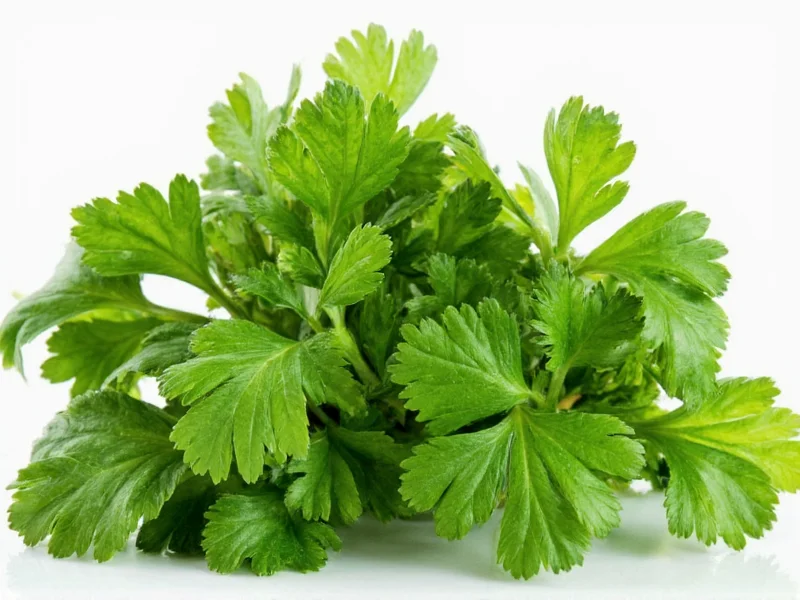Visual Identification: Spotting the Difference
Understanding how to visually distinguish cilantro from Italian parsley is essential for proper culinary use. While both are green leafy herbs, their physical characteristics differ significantly.
| Feature | Cilantro | Italian Parsley |
|---|---|---|
| Leaf Shape | Rounded, lacy edges with deep jagged cuts | Flat, broad leaves with fine serrations |
| Leaf Texture | Softer, more delicate | Firmer, slightly tougher |
| Stem Color | Pale green to light purple | Bright green |
| Plant Height | 12-24 inches | 10-18 inches |
| Overall Appearance | More feathery, delicate look | Bolder, more substantial appearance |
When examining fresh herbs at the market, look at the leaf shape first. Cilantro's leaves resemble small, rounded hearts with deeply serrated edges, while Italian parsley has broader, flatter leaves with finer serrations along the edges. The stems of cilantro often have a slight purple tint, especially near the base, whereas Italian parsley stems maintain a consistent bright green color.
Flavor Profile Comparison
The taste difference between cilantro vs Italian parsley represents their most significant culinary distinction. This difference explains why substituting one for the other can dramatically alter a dish's flavor profile.
Cilantro delivers a bright, citrusy flavor with notes of lemon and sage. Approximately 21% of the population carries a genetic variation that causes cilantro to taste like soap—a phenomenon known as cilantro aversion. This distinctive flavor makes cilantro essential in Latin American, Indian, and Southeast Asian cuisines. Heat diminishes cilantro's flavor quickly, so chefs typically add it at the end of cooking or use it raw in salsas and garnishes.
Italian parsley offers a milder, more neutral grassy flavor with subtle peppery notes. Unlike its curly cousin, Italian parsley provides clean herbal notes without overwhelming other ingredients. Its more robust nature withstands cooking better than cilantro, making it suitable for incorporation during cooking rather than just as a finishing herb. Professional chefs prefer Italian parsley for its consistent flavor and versatility across various cuisines.
Culinary Applications and Substitution Guidance
Understanding when to use cilantro vs Italian parsley can make or break your culinary creations. Each herb serves specific purposes based on its unique characteristics.
Cilantro shines in dishes where its bold flavor complements other ingredients: fresh salsas, guacamole, Thai curries, Vietnamese pho, and Indian chutneys. Its vibrant flavor pairs exceptionally well with lime, chili peppers, and garlic. When preparing Mexican dishes like pico de gallo or ceviche, substituting Italian parsley would create a noticeably different—and generally less authentic—flavor profile.
Italian parsley works as a versatile background herb that enhances rather than dominates. Chefs use it in French fines herbes blends, Middle Eastern tabbouleh, Italian gremolata, and as a standard garnish for countless dishes. Its mild flavor makes it ideal for dishes where you want herbal notes without the distinctive cilantro taste. In Mediterranean and European cuisines, Italian parsley often appears both during cooking and as a fresh garnish.
Can you substitute Italian parsley for cilantro? Only in specific circumstances. If a recipe calls for cilantro primarily for color or texture rather than flavor (such as a garnish on a dish where cilantro flavor isn't essential), Italian parsley might work. However, in recipes where cilantro's distinctive flavor is integral—like authentic salsa verde or Thai curry paste—substitution will significantly alter the dish's character. For those with cilantro aversion, Italian parsley provides a neutral alternative, though the dish won't have the intended flavor profile.
Nutritional Benefits Compared
Both herbs offer impressive nutritional profiles with some key differences that may influence your culinary choices.
Cilantro contains higher levels of vitamin K and provides notable amounts of vitamin A and vitamin C. It also contains antioxidants like quercetin and tocopherol. Research suggests cilantro may help reduce heavy metal accumulation in the body, though more studies are needed to confirm this benefit. The compound coriandrin in cilantro shows potential for blood sugar regulation.
Italian parsley surpasses cilantro in vitamin K content and provides exceptional amounts of vitamin C—more than oranges by weight. It's also rich in vitamin A, folate, and iron. The apiol and myristicin compounds in parsley show potential anti-inflammatory benefits. Both herbs contain minimal calories while delivering significant micronutrients, making them excellent additions to health-conscious cooking.
Shopping and Storage Tips
Selecting and storing these herbs properly preserves their flavor and extends their usability. When choosing between cilantro vs Italian parsley at the market:
- Look for vibrant green leaves without yellowing or wilting
- Check for crisp stems that snap when bent
- Avoid packages with excessive moisture or slimy leaves
- Smell the herbs—cilantro has a distinctive citrusy aroma while Italian parsley smells more subtly herbal
For storage, treat both herbs similarly but note their different shelf lives. Trim the stems and place them in a glass with an inch of water, covering loosely with a plastic bag. Store in the refrigerator. Cilantro typically lasts 5-7 days before wilting, while Italian parsley often remains fresh for 10-14 days due to its sturdier leaves. For longer storage, chop and freeze both herbs in ice cube trays with water or olive oil.
Common Misconceptions Clarified
Several misunderstandings surround cilantro vs Italian parsley that cause confusion among home cooks.
First, cilantro and coriander come from the same plant—cilantro refers to the leaves while coriander describes the seeds. This differs from Italian parsley, which belongs to a completely different botanical family. Second, Italian parsley is not simply a regional variety of cilantro; they're distinct species with different flavor compounds.
Many grocery stores label Italian parsley as simply "parsley," leading to confusion with curly parsley, which has a stronger flavor and different texture. True Italian parsley has flat leaves, while curly parsley features ruffled edges. When recipes specify "parsley" without qualification, they typically mean Italian flat-leaf parsley for its superior culinary qualities.











 浙公网安备
33010002000092号
浙公网安备
33010002000092号 浙B2-20120091-4
浙B2-20120091-4